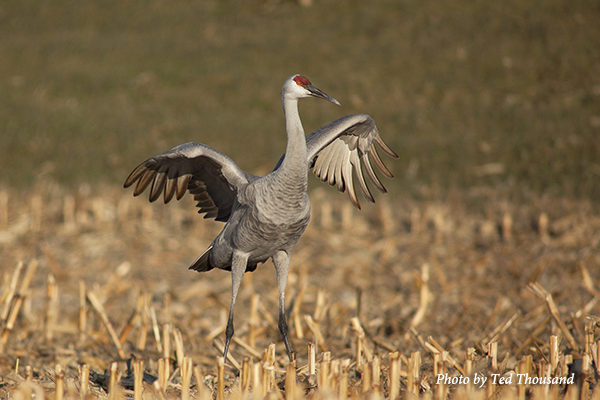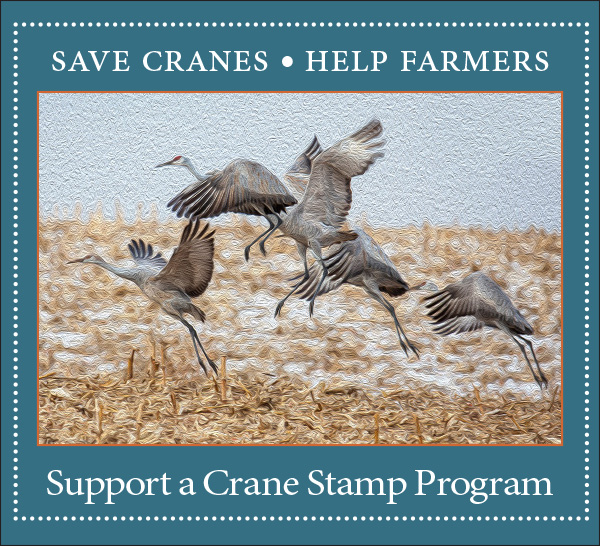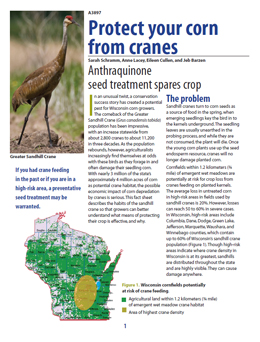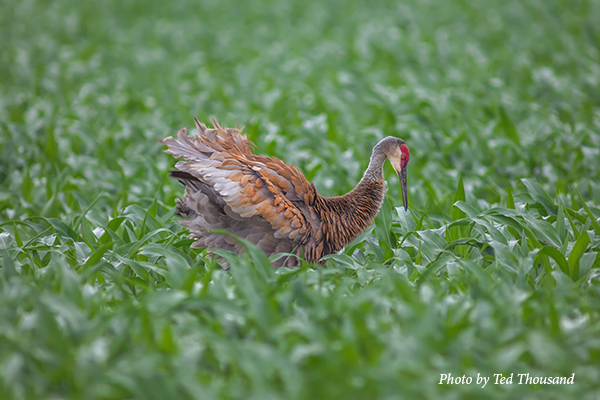
Sandhill Cranes and Wisconsin Farmers
Sandhill Cranes are a beloved species and a remarkable conservation success story. Nearly lost from Wisconsin last century, Sandhill Cranes have rebounded dramatically and tens of thousands now breed across our state or migrate through in the spring and fall. Most of their amazing recovery has occurred on Wisconsin’s agricultural fields and wetlands, and we are grateful to Wisconsin farmers for their lead role in supporting our cranes.
Sandhill Cranes support farmers too, eating waste grain, earthworms, and agricultural pests during most of the year. But in the spring, Sandhill Cranes feed on germinating corn seeds after planting and can cause significant damage to corn crops. Wisconsin farmers report nearly $1 million dollars in field corn losses each year due to Sandhill Canes, according to the U.S. Department of Agriculture. These losses are compounded by damage to corn by blackbirds, pheasants, and other birdlife.
Some have advocated for a Sandhill Crane hunting season in Wisconsin to address crop damage, but hunting is not a solution. There is no sustainable level of hunting of Sandhill Cranes that will solve crop damage or adequately compensate for crop losses. A limited hunting season for Sandhill Cranes would not eliminate cranes from farms and could not take place in spring when most crop damage occurs. An approved hunting season for cranes would allow farmers to qualify for claims under the statewide Wildlife Damage Abatement and Claims Program but would not produce nearly enough revenue to cover crop losses in the state. We estimate that a Sandhill Crane hunt in Wisconsin would operate at a net loss, with a low level of permit revenue and high administrative costs (including the cost of enrolling producers in the program, providing abatement assistance, conducting crop appraisals, processing damage claims, and providing damage prevention tools/supplies).
What do YOU think about a Wisconsin Sandhill Crane Stamp?
At the International Crane Foundation, we believe in healthy landscapes where farmers and cranes thrive together. A Sandhill Crane Stamp could be a valuable new tool for hunters and non-hunters to show their appreciation for wildlife on farmlands. What do you think? Would you buy a Sandhill Crane Stamp each year to show your support for farmers and wildlife? How much would you be willing to pay? Please share your thoughts with us.


There are solutions. The International Crane Foundation helped develop an effective, non-toxic chemical deterrent (Avipel) that is available to farmers and is scientifically proven to reduce crop damage by cranes and other birds. Avipel works, but it is costly for farmers, is inconvenient to use (must be applied to corn seed in the hopper), and is less effective if applied incorrectly.
To move forward, we are taking bold, creative action to support farmers and the wildlife that makes our state so special. We need programs that help farmers cover the added cost of treated corn seed. We need seed companies to sell treated corn seed with Avipel or other deterrents applied at the point of manufacture—such availability would substantially reduce the cost of deterrents per acre and the inconvenience of applying deterrents on the farm. We also need new deterrents for other crops that are impacted by Sandhill Cranes, especially potatoes, or help farmers to offset the financial losses from predation on those crops.
A Sandhill Crane Stamp
A Wisconsin Sandhill Crane Stamp is an innovative way to support farmers who support cranes and other non-game wildlife on their lands. A Sandhill Crane Stamp would be similar to the Federal duck stamp that hunters purchase each year but would not be linked to hunting. It would be a voluntary program promoted to the public, especially wildlife advocates, who value cranes and also want to assist farmers. Proceeds from the crane stamp would be earmarked to mitigate or compensate for the impacts of crop damage on farmers’ livelihoods. The funds could subsidize farmers’ purchase of chemical deterrents like Avipel or pre-treated corn. Revenue from the Sandhill Crane Stamp also could support research to develop new deterrents for potatoes and other vulnerable crops and help offset losses of those crops due to crane damage. A Sandhill Crane Stamp program could be administered through a government agency or by a non-profit organization such as the International Crane Foundation.

How much revenue would a Sandhill Crane Stamp produce?
We don’t know how many people would be willing to buy a Sandhill Crane Stamp to support farmers and conservation in Wisconsin. If the stamp cost $25 and was purchased by 50,000 people, it would produce $1.25 million to help farmers with crane-caused damage. Additional private donations could significantly increase the total available for farmers. This revenue would provide significantly more support for farmers, and lead to significantly less crop damage, than an abatement program based on a Sandhill Crane hunt.
